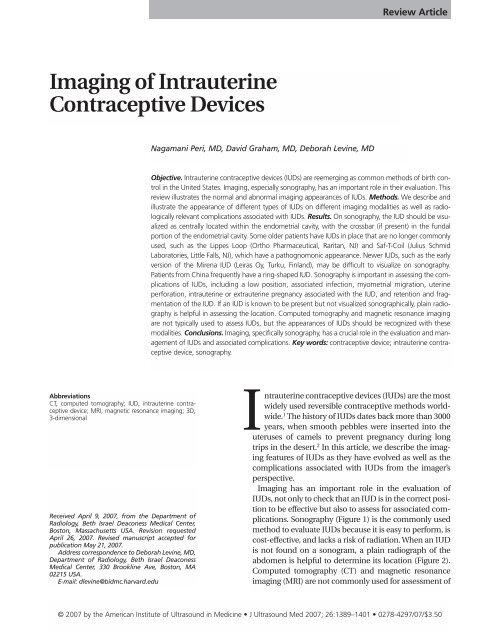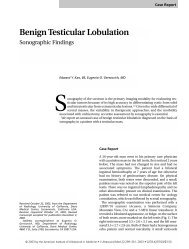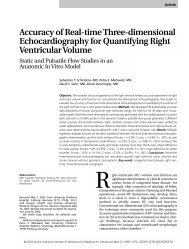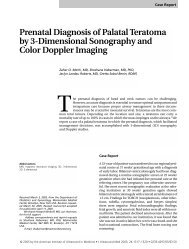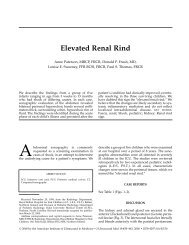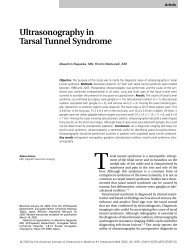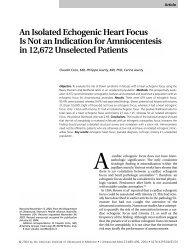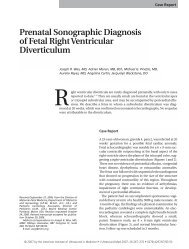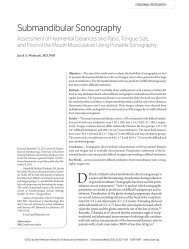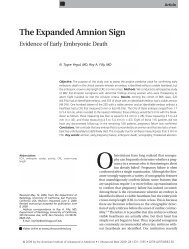Imaging of Intrauterine Contraceptive Devices - Journal of ...
Imaging of Intrauterine Contraceptive Devices - Journal of ...
Imaging of Intrauterine Contraceptive Devices - Journal of ...
You also want an ePaper? Increase the reach of your titles
YUMPU automatically turns print PDFs into web optimized ePapers that Google loves.
<strong>Imaging</strong> <strong>of</strong> <strong>Intrauterine</strong><br />
<strong>Contraceptive</strong> <strong>Devices</strong><br />
Abbreviations<br />
CT, computed tomography; IUD, intrauterine contraceptive<br />
device; MRI, magnetic resonance imaging; 3D,<br />
3-dimensional<br />
Received April 9, 2007, from the Department <strong>of</strong><br />
Radiology, Beth Israel Deaconess Medical Center,<br />
Boston, Massachusetts USA. Revision requested<br />
April 26, 2007. Revised manuscript accepted for<br />
publication May 21, 2007.<br />
Address correspondence to Deborah Levine, MD,<br />
Department <strong>of</strong> Radiology, Beth Israel Deaconess<br />
Medical Center, 330 Brookline Ave, Boston, MA<br />
02215 USA.<br />
E-mail: dlevine@bidmc.harvard.edu<br />
Nagamani Peri, MD, David Graham, MD, Deborah Levine, MD<br />
Review Article<br />
Objective. <strong>Intrauterine</strong> contraceptive devices (IUDs) are reemerging as common methods <strong>of</strong> birth control<br />
in the United States. <strong>Imaging</strong>, especially sonography, has an important role in their evaluation. This<br />
review illustrates the normal and abnormal imaging appearances <strong>of</strong> IUDs. Methods. We describe and<br />
illustrate the appearance <strong>of</strong> different types <strong>of</strong> IUDs on different imaging modalities as well as radiologically<br />
relevant complications associated with IUDs. Results. On sonography, the IUD should be visualized<br />
as centrally located within the endometrial cavity, with the crossbar (if present) in the fundal<br />
portion <strong>of</strong> the endometrial cavity. Some older patients have IUDs in place that are no longer commonly<br />
used, such as the Lippes Loop (Ortho Pharmaceutical, Raritan, NJ) and Saf-T-Coil (Julius Schmid<br />
Laboratories, Little Falls, NJ), which have a pathognomonic appearance. Newer IUDs, such as the early<br />
version <strong>of</strong> the Mirena IUD (Leiras Oy, Turku, Finland), may be difficult to visualize on sonography.<br />
Patients from China frequently have a ring-shaped IUD. Sonography is important in assessing the complications<br />
<strong>of</strong> IUDs, including a low position, associated infection, myometrial migration, uterine<br />
perforation, intrauterine or extrauterine pregnancy associated with the IUD, and retention and fragmentation<br />
<strong>of</strong> the IUD. If an IUD is known to be present but not visualized sonographically, plain radiography<br />
is helpful in assessing the location. Computed tomography and magnetic resonance imaging<br />
are not typically used to assess IUDs, but the appearances <strong>of</strong> IUDs should be recognized with these<br />
modalities. Conclusions. <strong>Imaging</strong>, specifically sonography, has a crucial role in the evaluation and management<br />
<strong>of</strong> IUDs and associated complications. Key words: contraceptive device; intrauterine contraceptive<br />
device, sonography.<br />
ntrauterine contraceptive devices (IUDs) are the most<br />
widely used reversible contraceptive methods worldwide.<br />
1 The history <strong>of</strong> IUDs dates back more than 3000<br />
years, when smooth pebbles were inserted into the<br />
uteruses <strong>of</strong> camels to prevent pregnancy during long<br />
trips in the desert. 2 I<br />
In this article, we describe the imaging<br />
features <strong>of</strong> IUDs as they have evolved as well as the<br />
complications associated with IUDs from the imager’s<br />
perspective.<br />
<strong>Imaging</strong> has an important role in the evaluation <strong>of</strong><br />
IUDs, not only to check that an IUD is in the correct position<br />
to be effective but also to assess for associated complications.<br />
Sonography (Figure 1) is the commonly used<br />
method to evaluate IUDs because it is easy to perform, is<br />
cost-effective, and lacks a risk <strong>of</strong> radiation. When an IUD<br />
is not found on a sonogram, a plain radiograph <strong>of</strong> the<br />
abdomen is helpful to determine its location (Figure 2).<br />
Computed tomography (CT) and magnetic resonance<br />
imaging (MRI) are not commonly used for assessment <strong>of</strong><br />
© 2007 by the American Institute <strong>of</strong> Ultrasound in Medicine • J Ultrasound Med 2007; 26:1389–1401 • 0278-4297/07/$3.50
<strong>Imaging</strong> <strong>of</strong> <strong>Intrauterine</strong> <strong>Contraceptive</strong> <strong>Devices</strong><br />
1390<br />
an IUD, but the IUD may be seen when these<br />
imaging studies are performed for other indications.<br />
When complications such as abscesses<br />
arise from an IUD, CT can be helpful in further<br />
management. 3,4 On CT, IUDs appear dense<br />
(Figure 3), and on MRI, they appear as signal<br />
voids (Figure 4). It is safe to perform MRI at 1.5 T<br />
and lower magnet strengths in patients with<br />
IUDs. At 3 T, metal-free IUDs appear to be safe.<br />
However, the safety <strong>of</strong> metal-containing IUDs at<br />
3 T has not yet been proven, with theoretic risks<br />
<strong>of</strong> heating or motion. 5<br />
<strong>Intrauterine</strong> contraceptive devices can be<br />
divided into 3 basic types: (1) inert, (2) copper<br />
containing (first and second generation), and (3)<br />
hormone containing. It is helpful to know the<br />
type <strong>of</strong> IUD inserted for accurate assessment. In<br />
a T-shaped IUD, the stem and the arms <strong>of</strong> the T<br />
Figure 1. Copper IUD. Sagittal transabdominal (A) and transvaginal<br />
(B) sonograms show the echogenic shaft <strong>of</strong> the copper IUD,<br />
with shadowing best seen on the transvaginal image.<br />
A<br />
B<br />
should be identified, with the proximal end in the<br />
internal os and the distal end in the fundal region<br />
within the endometrium. If an IUD is difficult to<br />
visualize, assessing its shadow may be helpful<br />
(Figure 5). Some advocate 3-dimensional (3D)<br />
sonography to ensure that the entire IUD is within<br />
the endometrial cavity (Figure 6). Volume contrast<br />
imaging with a 2- to 4-mm slice thickness,<br />
showing the acoustic shadows, can also be helpful,<br />
especially in the presence <strong>of</strong> uterine anomalies,<br />
scarring, and other technically difficult<br />
situations. 6<br />
Types <strong>of</strong> IUDs<br />
Inert IUDs<br />
To our knowledge, the first IUD used in humans<br />
was a ring-shaped device, developed in the early<br />
1900s by Ernst Grafenberg. 7 However, this was<br />
not widely used because <strong>of</strong> fear <strong>of</strong> infection and<br />
difficulty <strong>of</strong> removal. The first American IUD<br />
was the Margulies spiral (Gynecoil; Ortho<br />
Pharmaceutical, Raritan, NJ), which frequently<br />
caused bleeding and cramping and had a hard,<br />
uncomfortable tail. It was modified by Jack<br />
Lippes, who created the Lippes Loop IUD (Ortho<br />
Pharmaceutical), changed the ring to a loop for<br />
easy removal, and also attached a s<strong>of</strong>ter string for<br />
checking its position. This IUD is curved back and<br />
Figure 2. <strong>Intrauterine</strong> contraceptive device in the peritoneal<br />
cavity <strong>of</strong> a patient with a nonvisualized IUD on sonography. Plain<br />
radiograph shows a Mirena IUD in the left hemipelvis. This was<br />
confirmed to have perforated into the cul-de-sac at laparoscopy.<br />
J Ultrasound Med 2007; 26:1389–1401
forth on itself and thus on a sagittal image has an<br />
appearance <strong>of</strong> 5 echogenic foci aligned in the<br />
endometrial cavity with shadowing (Figure 7).<br />
In the late 1960s, the Lippes Loop was followed<br />
by another inert IUD, the Saf-T-coil (Julius<br />
Schmid Laboratories, Little Falls, NJ), which has<br />
a seagull-shaped appearance in the crossbars.<br />
These IUDs were made <strong>of</strong> plastic polyethylene<br />
with some barium sulfate added so that they<br />
could be visualized on radiographs.<br />
These inert IUDs were in wide use before the<br />
introduction <strong>of</strong> copper-containing IUDs. Several<br />
other IUDs were available in the late 1960s and<br />
1970s, some <strong>of</strong> which were associated with complications,<br />
controversies, and lawsuits which<br />
made IUDs less popular as contraceptive methods.<br />
The most controversial IUD was the Dalkon<br />
Shield (A. H. Robins Company, Richmond, VA),<br />
which looked like a bug with 1 large eye and<br />
5 legs on each side. It had a braided tail consisting<br />
<strong>of</strong> multiple filaments enclosed in a sheath<br />
(Figure 8). 7 This multifilament tail acted as a<br />
source <strong>of</strong> infection, leading to pelvic inflammatory<br />
disease and septic abortions.<br />
An inert IUD that is still in use today is the<br />
ring-shaped IUD, widely used in China (Figure<br />
9). These are typically inserted in patients<br />
postpartum. They have a higher failure rate<br />
than the T-shaped IUDs and are also difficult<br />
to remove. 8<br />
Figure 3. Axial CT image shows a dense copper IUD located in<br />
the endometrial cavity.<br />
Copper-Containing IUDs<br />
Copper-containing IUDs are <strong>of</strong> several different<br />
types and consist <strong>of</strong> first generation-models developed<br />
in early 1970s, such as the Copper 7 (G. D. Searle<br />
& Company, High Wycombe, England), secondgeneration<br />
types such as the Nova T (Leiras Oy,<br />
Turku, Finland), and third-generation types<br />
such as the T Cu380A (ParaGard; GynoPharma,<br />
Summerville, NJ). The various types <strong>of</strong> copper IUDs<br />
release varying amounts <strong>of</strong> elemental copper and<br />
have different effective periods. The local increase<br />
in copper levels leads to decreased sperm motility<br />
and irritation <strong>of</strong> the endometrium and is<br />
possibly ovicidal. These IUDs typically have a<br />
straight shaft and crossbars that form the shape<br />
<strong>of</strong> a 7 or a T (Figures 1 and 10). Because <strong>of</strong> the<br />
dense composition <strong>of</strong> the straight shaft, a ring-<br />
Figure 4. Magnetic resonance imaging appearance <strong>of</strong> an IUD.<br />
Sagittal T2-weighted (A) and coronal short tau inversion recovery<br />
(B) views show linear signal voids (arrows) in the endometrium<br />
from the IUD.<br />
A<br />
B<br />
Peri et al<br />
J Ultrasound Med 2007; 26:1389–1401 1391
<strong>Imaging</strong> <strong>of</strong> <strong>Intrauterine</strong> <strong>Contraceptive</strong> <strong>Devices</strong><br />
1392<br />
Figure 5. <strong>Intrauterine</strong> contraceptive device shadow. Sagittal<br />
transvaginal sonogram shows strong shadowing from a Mirena<br />
IUD, which can help in identification <strong>of</strong> an otherwise difficult-tovisualize<br />
IUD.<br />
Figure 6. Coronal 3D reconstructed sonogram <strong>of</strong> a Mirena<br />
IUD shows the expected location <strong>of</strong> the shaft and crossbars<br />
simultaneously.<br />
Figure 7. Lippes Loop on multiple modalities. A, Pelvic radiograph<br />
shows the curved appearance. B and C, Sagittal CT reconstruction<br />
(B) and transvaginal sonogram (C) show 5 intermittent<br />
echogenic shadowing foci.<br />
A<br />
B<br />
C<br />
J Ultrasound Med 2007; 26:1389–1401
Figure 8. Dalkon shield. A and B, Sagittal (A) and transverse<br />
(B) sonograms <strong>of</strong> the uterus with a Dalkon shield IUD.<br />
C, Abdominal CT image <strong>of</strong> the same patient shows the characteristic<br />
appearance <strong>of</strong> a bug with 5 legs on each side. Note<br />
the difficult sonographic visualization <strong>of</strong> the entire IUD.<br />
A<br />
B<br />
C<br />
Figure 9. Stainless steel ring IUD. Sagittal (A), oblique sagittal<br />
(B), and transverse (C) sonograms <strong>of</strong> the uterus show the ring<br />
appearance <strong>of</strong> the IUD.<br />
A<br />
B<br />
C<br />
Peri et al<br />
J Ultrasound Med 2007; 26:1389–1401 1393
<strong>Imaging</strong> <strong>of</strong> <strong>Intrauterine</strong> <strong>Contraceptive</strong> <strong>Devices</strong><br />
1394<br />
down artifact may be seen behind these IUDs.<br />
The copper IUD available in the United States is<br />
the ParaGard IUD, which is effective for 10 years. 9<br />
Hormone-Containing IUDs<br />
Hormone-containing IUDs have either natural<br />
progesterone hormone (Progestasert; Alza<br />
Corporation, Palo Alto, CA), with 38 mg <strong>of</strong> naturally<br />
occurring progesterone in the reservoir,<br />
effective for 1 year (Figure 11), or levonorgestrel,<br />
Figure 10. ParaGard IUD. A, Coronal sonogram <strong>of</strong> a retr<strong>of</strong>lexed<br />
uterus shows a ParaGard IUD in the expected location in the<br />
endometrial cavity. B, In a different patient, axial CT image<br />
shows the radiopaque metallic IUD in the expected location in<br />
the mid uterus.<br />
A<br />
B<br />
which is a synthetic progestogen. These became<br />
available for clinical use in 2001 in the United<br />
States as Mirena (Leiras Oy) and earlier elsewhere<br />
as Levo Nova (Leiras Oy). Levonorgestrelcontaining<br />
IUDs are highly effective, with a very<br />
low failure rate. 10 The levonorgestrel-containing<br />
IUDs have the additional advantage <strong>of</strong><br />
reducing menorrhagia, dysmenorrheal, and<br />
anemia. 11–15<br />
The Mirena IUD has a T-shaped polyethylene<br />
frame, with a 32-mm vertical stem and a 32-mm<br />
horizontal portion with arms containing barium<br />
sulfate. The stem has a reservoir containing a<br />
mixture <strong>of</strong> levonorgestrel and silicone covered by<br />
a silicone membrane. 16 The Mirena IUD has a<br />
characteristic appearance, with acoustic shadowing<br />
between the echogenic proximal and distal<br />
ends, unlike copper IUDs, which are more<br />
completely echogenic (Figure 12). 17 Early versions<br />
<strong>of</strong> the Mirena IUD were very difficult to<br />
visualize sonographically (Figure 13). The string<br />
can have a very echogenic appearance. 17 In our<br />
anecdotal experience, more recent versions have<br />
a more easily identifiable IUD shaft appearance<br />
and a slightly less echogenic but still readily identifiable<br />
string (Figure 12).<br />
Essure Device<br />
A recent contraceptive device is the Essure device<br />
(Conceptus, San Carlos, CA). This is a permanent<br />
sterilization device consisting <strong>of</strong> 2 microinsert<br />
coils that are hysteroscopically placed in each<br />
Figure 11. Progestasert IUD. Sagittal sonographic image <strong>of</strong> the<br />
uterus shows the echogenic proximal and distal ends (arrows)<br />
and shadowing in between.<br />
J Ultrasound Med 2007; 26:1389–1401
fallopian tube. The Essure microinsert consists<br />
<strong>of</strong> a stainless steel inner coil, a nickel-titanium<br />
superelastic outer coil, and polyethylene fibers<br />
that are wound in and around the inner coil. The<br />
microinsert is 4 cm in length and 0.8 mm in<br />
diameter. When released, the outer coil expands<br />
to 1.5 to 2 mm to anchor the microinsert in the<br />
fallopian tube. The fibers stimulate tissue<br />
ingrowth. Along with the microinsert coil, these<br />
fibers act as scaffolding into which the tissue<br />
grows, further anchoring the microinsert within<br />
the fallopian tube and occluding the tubal lumen,<br />
resulting in sterilization. 18 Hysterosalpingography<br />
is performed about 3 months after the<br />
procedure to document tubal occlusion. On<br />
Figure 12. Mirena IUD. Sagittal (A) and coronal (B) transvaginal<br />
sonograms show the echogenic T-shaped Mirena IUD with the<br />
crossbars in the expected location in the endometrium, just<br />
below the fundus.<br />
A<br />
B<br />
Figure 13. Mirena IUD. A, Transabdominal sagittal image<br />
shows the difficult-to-visualize shaft <strong>of</strong> the IUD. B, Transvaginal<br />
sagittal image shows the echogenic string in the cervix (arrow).<br />
C, Transvaginal coronal image shows the difficult-to-visualize<br />
crossbars (arrows).<br />
A<br />
B<br />
C<br />
Peri et al<br />
J Ultrasound Med 2007; 26:1389–1401 1395
<strong>Imaging</strong> <strong>of</strong> <strong>Intrauterine</strong> <strong>Contraceptive</strong> <strong>Devices</strong><br />
1396<br />
sonography, the Essure device appears as a curvilinear,<br />
dense, uniformly echogenic structure with<br />
shadowing in the region <strong>of</strong> the fallopian tube, with<br />
the proximal tip at the uterine cornu (Figure 14).<br />
Complications <strong>of</strong> IUDs<br />
The radiologically relevant complications <strong>of</strong> IUDs<br />
include malposition, uterine perforation, pelvic<br />
inflammatory disease, and pregnancy. These<br />
issues are discussed in the following sections.<br />
Figure 14. Essure device. A, Transverse transabdominal sonogram<br />
shows the curvilinear, uniformly echogenic Essure device<br />
(arrows) extending from the uterine fundus to the fallopian<br />
tubes bilaterally. B, In a different patient, scout radiograph with<br />
the hysterosalpingographic catheter in place shows the<br />
radiopaque Essure device bilaterally.<br />
A<br />
B<br />
Malposition <strong>of</strong> the IUD<br />
A low position <strong>of</strong> an IUD is a commonly encountered<br />
complication, with the patient usually having<br />
a long string. The malpositioned IUD can be<br />
visualized with the tip in the mid or lower uterus<br />
or in the cervix (Figure 15). When an IUD is low, it<br />
is not effective as a contraceptive. Malpositioned<br />
IUDs can be a cause <strong>of</strong> pain, especially during<br />
Figure 15. Low position <strong>of</strong> an IUD. Sagittal transabdominal (A)<br />
and transvaginal (B) sonograms show a ParaGard IUD low in the<br />
uterus, extending into the cervix. In this position, the patient will<br />
frequently have pain. The low-positioned IUD is not effective for<br />
contraception and needs to be replaced.<br />
A<br />
B<br />
J Ultrasound Med 2007; 26:1389–1401
intercourse. <strong>Intrauterine</strong> contraceptive devices<br />
in a slightly low position may spontaneously<br />
migrate into a normal position in 2 to 3 months. 19<br />
However, in general, malpositioned IUDs should<br />
be removed and replaced. Three-dimensional<br />
transvaginal sonography has been shown to be<br />
more accurate in identifying the type and location<br />
<strong>of</strong> the IUD than 2-dimensional transvaginal<br />
sonography. 20 Because structures that are not<br />
located in the same plane can be imaged simultaneously<br />
with this technique, 3D sonography is<br />
especially useful in accurate evaluation <strong>of</strong> misplaced<br />
IUDs. 21<br />
In patients with prior uterine surgery, it is possible<br />
that the IUD will migrate into the scar and<br />
be a cause <strong>of</strong> pain. In our anecdotal experience,<br />
patients with prior cesarean deliveries may have<br />
extension <strong>of</strong> the lower end <strong>of</strong> the IUD into the<br />
scar (Figure 16). However, the clinical importance<br />
<strong>of</strong> this is uncertain.<br />
Malposition can also occur when the shaft or<br />
crossbar <strong>of</strong> an IUD extends into the myometrium.<br />
The patient may have pain. Clues to this<br />
Figure 16. <strong>Intrauterine</strong> contraceptive device in a cesarean delivery<br />
scar in a patient with pelvic pain. Sagittal transvaginal sonogram<br />
shows the lower portion <strong>of</strong> a Mirena IUD (arrow) extending<br />
into the defect <strong>of</strong> the cesarean delivery scar.<br />
diagnosis are when the crossbars are low in the<br />
uterus or when they extend in an anteroposterior<br />
direction rather than the typical transverse<br />
position in the uterine fundus (Figure 17).<br />
Extension into the myometrium typically occurs<br />
at the time <strong>of</strong> insertion. When scanning women<br />
with IUDs in place, it is important to assess for<br />
extension <strong>of</strong> the echogenic portion <strong>of</strong> the IUD<br />
outside the endometrium into the myometrium.<br />
Sometimes this can be a subtle finding, seen only<br />
on a single image.<br />
Uterine Expulsion<br />
When the string <strong>of</strong> the IUD cannot be felt on<br />
physical examination, the possibilities are as<br />
follows: (1) the IUD has been ejected from the<br />
uterus; (2) the IUD is in the uterus (in either a<br />
normal or an abnormal location), but the string<br />
is broken or misplaced; and (3) the uterus has<br />
perforated, and the IUD is no longer in the<br />
endometrial cavity. The expulsion rate is highest<br />
when the IUD is placed in the immediate postpartum<br />
period after a vaginal delivery. 22<br />
Figure 17. <strong>Intrauterine</strong> contraceptive device perforation.<br />
Sagittal transvaginal sonogram shows one <strong>of</strong> the crossbars<br />
(arrow) <strong>of</strong> the IUD extending out <strong>of</strong> the endometrial cavity into<br />
the myometrium.<br />
Peri et al<br />
J Ultrasound Med 2007; 26:1389–1401 1397
<strong>Imaging</strong> <strong>of</strong> <strong>Intrauterine</strong> <strong>Contraceptive</strong> <strong>Devices</strong><br />
1398<br />
Uterine Perforation<br />
The perforation rate for IUDs is quoted as 1 to 2<br />
per 1000 and is increased in the following<br />
instances: (1) with placement by inexperienced<br />
operators; (2) when the IUD is placed less than<br />
6 months postpartum; (3) in women with fewer<br />
prior pregnancies; and (4) in women with an<br />
increased number <strong>of</strong> miscarriages. 23 When the<br />
IUD migrates outside the uterus, it can lead to<br />
additional complications, such as bowel or<br />
bladder perforation. 24 In addition, in a hormone-containing<br />
IUD, the serum hormone<br />
levels can be up to 10 times higher when the<br />
IUD is in a peritoneal location than when it is<br />
intrauterine. When an IUD cannot be visualized<br />
sonographically, a plain radiograph <strong>of</strong> the<br />
abdomen can help in localizing the IUD (Figure<br />
2). A CT scan <strong>of</strong> the abdomen can help in more<br />
accurate localization <strong>of</strong> an IUD for appropriate<br />
management.<br />
Pregnancy in Patients With IUDs in Place<br />
When pregnancy occurs with an IUD in the<br />
uterus, the pregnancy is usually ectopic because<br />
implantation is unlikely to occur in the endometrial<br />
cavity (Figure 18). Therefore, patients with<br />
IUDs in place and positive pregnancy test results<br />
should be expected to have ectopic pregnancy<br />
until proven otherwise. However, intrauterine<br />
pregnancy can also occur (Figure 19). In patients<br />
with IUDs and intrauterine pregnancy, the IUD<br />
typically is removed under sonographic guidance<br />
to lessen the risks <strong>of</strong> infection, miscarriage,<br />
and premature delivery, which can occur if the<br />
IUD is left in place. 25<br />
Pelvic Inflammatory Disease<br />
Patients with IUDs are at increased risk <strong>of</strong> pelvic<br />
inflammatory disease, although this risk is less<br />
common than in the past. The presence <strong>of</strong> cervical<br />
chlamydial or gonorrheal infection at the<br />
time <strong>of</strong> insertion <strong>of</strong> an IUD increases the risk <strong>of</strong><br />
infection. 26 Pelvic inflammatory disease can<br />
manifest as endometritis, pyosalpinx, or a tuboovarian<br />
abscess (Figures 20 and 21). A CT scan<br />
<strong>of</strong> the pelvis is useful in evaluating the extent <strong>of</strong><br />
inflammatory disease. 27,28<br />
Retention and Fragmentation<br />
An IUD left in the uterus for a prolonged period<br />
can become encrusted with a fibrous reaction<br />
and can be difficult to remove. At times, there can<br />
be fragmentation and retention <strong>of</strong> all or portions<br />
<strong>of</strong> the IUD (Figure 22).<br />
Figure 18. Ectopic pregnancy in a patient with an IUD in the<br />
uterus and a human chorionic gonadotropin value <strong>of</strong> 1300 mIU/<br />
mL 5 weeks 5 days after her last menstrual period. A, Sagittal<br />
transvaginal sonogram shows the IUD in the uterus. There was<br />
also free fluid in the pelvis (not shown). B, Transvaginal transverse<br />
sonogram shows a left adnexal mass (arrow) superior to and separate<br />
from the ovary on real-time imaging. This was confirmed to<br />
be an ectopic pregnancy at surgery.<br />
A<br />
B<br />
J Ultrasound Med 2007; 26:1389–1401
Figure 19. <strong>Intrauterine</strong> contraceptive device and intrauterine<br />
gestation. Sagittal transvaginal sonogram shows an intrauterine<br />
gestational sac adjacent to the IUD.<br />
Conclusions<br />
<strong>Imaging</strong>, especially sonography, has a crucial role<br />
in evaluation IUD locations as well as management<br />
<strong>of</strong> associated complications. Knowledge <strong>of</strong><br />
the various types <strong>of</strong> IUDs and their appearances<br />
will aid the imager in accurate assessment <strong>of</strong> the<br />
various types <strong>of</strong> IUDs.<br />
Figure 20. Pyohematometra in association with an IUD. Sagittal<br />
transvaginal sonogram shows a distended uterus with complex<br />
echogenic fluid and a Lippes Loop IUD in a low position. At<br />
surgery, pyohematometra was confirmed.<br />
Figure 21. Ring IUD and pelvic inflammatory disease in a<br />
woman with vaginal bleeding, left lower quadrant pain, and<br />
fever. A, Sagittal transabdominal sonogram shows the IUD and<br />
a complex fluid collection in the left adnexa (arrow). The IUD<br />
was removed, and patient improved with antibiotics.<br />
B, Transverse transabdominal sonogram shows the ring-shaped<br />
IUD in the uterus. C, Sagittal transvaginal sonogram shows the<br />
internal architecture <strong>of</strong> the left adnexal complex fluid collection<br />
more clearly (arrow).<br />
A<br />
B<br />
C<br />
Peri et al<br />
J Ultrasound Med 2007; 26:1389–1401 1399
<strong>Imaging</strong> <strong>of</strong> <strong>Intrauterine</strong> <strong>Contraceptive</strong> <strong>Devices</strong><br />
1400<br />
A<br />
B<br />
Figure 22. Fragmented ring IUD in a patient who had pelvic<br />
pain and bleeding. A, Sagittal sonogram shows a discontinuous<br />
echogenic foreign body in the uterus. B, Frontal pelvic radiograph<br />
shows a fragmented IUD.<br />
References<br />
1. Tatum HJ. <strong>Intrauterine</strong> contraception. Am J Obstet Gynecol<br />
1972; 112:1000–1023.<br />
2. Mbabajende V. Historical survey <strong>of</strong> modern reversible contraceptive<br />
methods. Imbonezamuryango 1986; 5:14–17.<br />
3. Tyrrel T, Murphy FB, Bernardino ME. Tubo-ovarian abscesses:<br />
CT-guided percutaneous drainage. Radiology 1990;<br />
175:87–89.<br />
4. Kim SH, Kim SH, Yang DM, Kim KA. Unusual causes <strong>of</strong><br />
tubo-ovarian abscess: CT and MR imaging findings.<br />
Radiographics 2004; 24:1575–1589.<br />
5. Muhler M, Taupitz M. How safe is magnetic resonance<br />
imaging in patients with contraceptive implants? Radiologe<br />
2006; 46:574–578.<br />
6. Valsky DV, Cohen SM, Hochner-Celnikier D, Lev-Sagie A,<br />
Yagel S. The shadow <strong>of</strong> the intrauterine device.<br />
J Ultrasound Med 2006; 25:613–616.<br />
7. Westh<strong>of</strong>f C. The IUD in evolution. Obstet Gynecol Surv<br />
1996; 51:S20–S24.<br />
8. Kaufman J. The cost <strong>of</strong> IUD failure in China. Stud Fam<br />
Plann 1993; 24:194–196.<br />
9. Kaunitz AM. Reappearance <strong>of</strong> the intrauterine device: a<br />
“user-friendly” contraceptive. Int J Fertil Womens Med<br />
1997; 42:120–127.<br />
10. Andersson K. The levonorgestrel intrauterine system: more<br />
than a contraceptive. Eur J Contracept Reprod Health Care<br />
2001; 1:15–22.<br />
11. Sivin I, Stern J. Health during prolonged use <strong>of</strong> levonorgestrel<br />
20 micrograms/d and the copper TCu 380Ag<br />
intrauterine contraceptive devices: a multicenter study.<br />
International Committee for Contraception Research<br />
(ICCR). Fertil Steril 1994; 61:70–77.<br />
12. Baveja R, Bichille LK, Coyaji KJ, et al. Randomized clinical<br />
trial with intrauterine devices (levonorgestrel intrauterine<br />
device (LNG), CuT 380Ag, CuT 220C and CuT 200B): a 36month<br />
study. Indian Council <strong>of</strong> Medical Research Task<br />
Force on IUD. Contraception 1989; 39:37–52.<br />
13. Arias RD. Compelling reasons for recommending IUDs to<br />
any woman <strong>of</strong> reproductive age. Int J Fertil Womens Med<br />
2002; 47:87–95.<br />
14. Vercellini P, Frontino G, De Giorgi O, Aimi G, Zaina B,<br />
Crosignani PG. Comparison <strong>of</strong> levonorgestrel-releasing<br />
intrauterine device versus expectant management after<br />
conservative surgery for symptomatic endometriosis: a pilot<br />
study. Fertil Steril 2003; 80:305–309.<br />
15. Hubacher D, Grimes DA. Noncontraceptive health benefits<br />
<strong>of</strong> intrauterine devices: a systematic review. Obstet Gynecol<br />
Surv 2002; 57:120–128.<br />
16. Mirena [product information]. Turku, Finland: Schering Oy;<br />
2006.<br />
17. Zalel Y. Sonographic and Doppler flow characteristics <strong>of</strong><br />
levonorgestrel and copper-releasing intrauterine devices.<br />
MedGenMed 2003; 5:38.<br />
18. Essure [product information]. San Carlos, CA: Conceptus,<br />
Inc; 2006.<br />
19. Morales-Rosello J. Spontaneous upward movement <strong>of</strong> lowly<br />
placed T-shaped IUDs. Contraception 2005; 72:430–431.<br />
20. Bonilla-Musoles F, Raga F, Osborne NG, Blanes J. Control <strong>of</strong><br />
intrauterine device insertion with three-dimensional ultrasound:<br />
is it the future? J Clin Ultrasound 1996;<br />
24:263–267.<br />
21. Lee A, Eppel W, Sam C, Kratochwil A, Deutinger J,<br />
Bernaschek G. <strong>Intrauterine</strong> device localization by threedimensional<br />
transvaginal ultrasonography. Ultrasound<br />
Obstet Gynecol 1997; 10:289–292.<br />
J Ultrasound Med 2007; 26:1389–1401
22. Muller LAL, Ramos LJG, Martins-Costa SH, et al. Transvaginal<br />
ultrasonographic assessment <strong>of</strong> the expulsion rate <strong>of</strong><br />
intrauterine devices inserted in the immediate postpartum<br />
period: a pilot study. Contraception 2005; 72:192–195.<br />
23. Caliskan E, Ozturk N, Dilbaz BO, Dilbaz S. Analysis <strong>of</strong> risk factors<br />
associated with uterine perforation by intrauterine<br />
devices. Eur J Contracept Reprod Health Care 2003; 8:150–<br />
155.<br />
24. Honarbakhsh A, Rastegar M, Hervai I, Khoury E.<br />
Unrecognised perforation <strong>of</strong> the uterus into bladder by an<br />
IUD. J Obstet Gynaecol 2003; 23:444–445.<br />
25. Schiesser M, Lapaire O, Tercanli S, Holzgreve W. Lost<br />
intrauterine devices during pregnancy: maternal and fetal<br />
outcome after ultrasound-guided extraction. An analysis <strong>of</strong><br />
82 cases. Ultrasound Obstet Gynecol 2004; 23:486–489.<br />
26. Mohllajee AP, Curtis.KM, Peterson HB. Does insertion and<br />
use <strong>of</strong> an intrauterine device increase the risk <strong>of</strong> pelvic<br />
inflammatory disease among women with sexually transmitted<br />
infection? A systematic review. Contraception 2006;<br />
73:145–153.<br />
27. Sam JW, Jacobs JE, Birnbaum BA. Spectrum <strong>of</strong> CT findings<br />
in acute pyogenic pelvic inflammatory disease.<br />
Radiographics 2002; 22:1327–1334.<br />
28. Huch Boni RA, Heusler RH, Hebisch G, Krestin GP. CT and<br />
MRI in inflammations <strong>of</strong> female genital organs. Radiologe<br />
1994; 34:390–396.<br />
Peri et al<br />
J Ultrasound Med 2007; 26:1389–1401 1401


